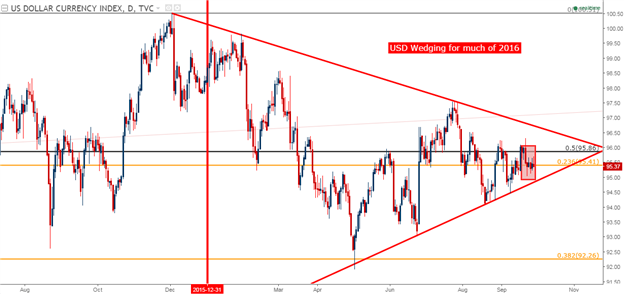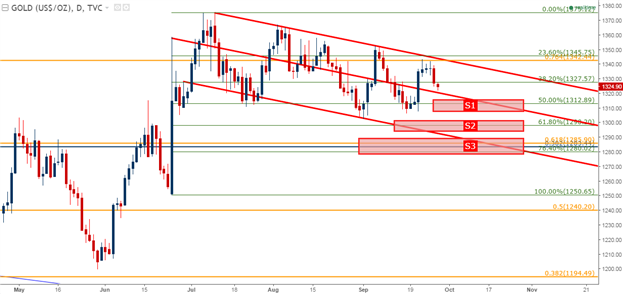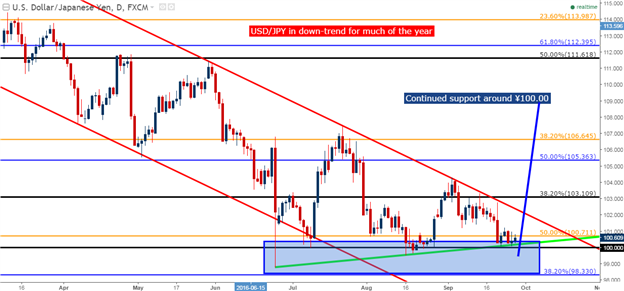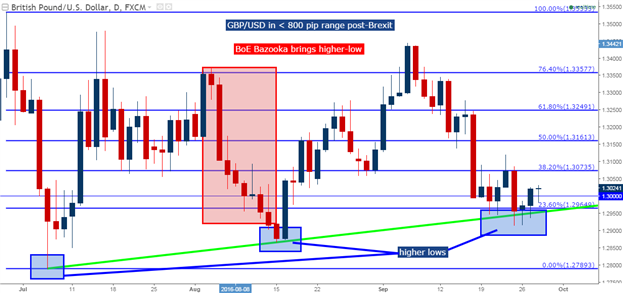Talking Points:
- Last week’s Fed meeting brought on the hawkish-hold that many were looking for, but dovishness for 2017 and thereafter have produced a lack of direction in the US Dollar; and the greenback is continuing to work in a symmetrical wedge formation that’s been building for much of 2016.
- With five Fed members on the docket for speeches today, the possibility exists for some element of trends to be seen in USD-related markets. We look at three of the more interesting below.
- If you’re looking for trading ideas, check out our Trading Guides. If you’re looking for an even shorter-term indicator, check out our recently-unveiled GSI indicator.
To receive James Stanley’s analysis directly via email, please SIGN UP HERE
Last week brought the widely-awaited September Fed meeting; and while the bank did point at the possibility of a 2016 rate hike, as many thought they would, they also downgraded expectations for 2017 and thereafter. So while the Fed was hawkish for the remainder of the year, they were dovish beyond that and this has brought a choppy lack of direction into the US Dollar.
With five Fed speakers on the docket for this afternoon, and with even more Fedspeak due for later in the week, a market searching for direction may get the motivation that it’s looking for should any of these speeches get especially passive or aggressive towards rate hike plans. If you want a preview of the Fed speeches on the docket for later today, Chris Vecchio outlined those in his morning piece today. Below, we look at the current setup in the US Dollar followed by three of the more interesting USD-markets as we approach this fresh batch of Fedspeak.
The US Dollar has been building in Symmetrical Wedge formation for much of 2016

Chart prepared by James Stanley
One market that’s remained volatile around USD-movements within that wedge formation this year has been Gold. As the US Dollar was diving in the early portion of this year, Gold prices caught a major bid as the Federal Reserve was backing away from their aggressive 2016 rate hike plans. This had led to as much as a 29% move in Gold prices from the open of the year to the July high at $1,375.
More recently, Gold prices have been consolidating after another bullish move post-Brexit, producing a bull flag formation with a downward sloping channel near the top of a top-side move.
Should FOMC dovishness or USD-weakness enter the picture, this will likely remain as one of the more attractive markets to be focusing on. For now, given the consolidation pattern that’s been seen as the Fed has remained relatively hawkish for the remainder of the year, traders would likely want to wait for either a) a deeper level of support or b) a top-side break of the channel to denote the potential for continuation of a bullish move. We went over this setup and strategy in the article, Gold Prices Pop after Fed, but Remain in Bearish Channel.
Gold Prices Trading in Bull Flag Formation While USD Congests

Chart prepared by James Stanley
Another market that’s seen an incredibly weak US Dollar this year has been against the Japanese Yen. For much of the year markets have debated the prospect of additional Japanese stimulus. And while we’ve seen some movement on that front, the BoJ has yet to deliver the ‘knockout punch’ to deflation that so many are hoping that they try to embark upon. As hope or anticipation for more stimulus has come into the equation, USD/JPY has shown a tendency to rocket-higher. But as those hopes fall flat, the pair reverses and trades lower even more aggressively as those stimulus bets price-out of the market.
The hope for additional stimulus is likely helping to keep this pair supported at the moment. Should the Fed display a hawkish stance, driving USD-strength, this could be an attractive area to focus on given the potential for Yen-weakness later in the year.

Chart prepared by James Stanley
Another market that’s seen considerable volatility this year around the US Dollar, albeit for a different set of reasons and an entirely different direction, has been the British Pound. The Sterling was roiled around the Brexit referendum with the ‘sharp repricing’ that Mark Carney told us was coming. But it wasn’t just the fear around the Brexit referendum that’s driven the currency, and perhaps more likely this was the extremely dovish drives from the Bank of England in the post-Brexit referendum environment that’s evoked a considerable portion of the currency’s movement.
The big question now is whether inflationary pressure, brought upon by this sharp repricing in the value of the British Pound, may bring on inflationary pressure in the coming months. After the BOE launched a ‘bazooka’ worth of stimulus last month, GBP/USD merely made a higher-low. And after another batch of BOE dovishness in early September, assuring markets that the bank could get even more passive on rates in the coming quarters, and the pair made another higher-low, bouncing off of a projected trend-line connecting the ‘post Brexit’ low to the ‘Bazooka low.’
Should USD weakness or FOMC dovishness come into the picture, this could be an attractive market to investigate with the aim of reversal plays.

Chart prepared by James Stanley
--- Written by James Stanley, Analyst for DailyFX.com
To receive James Stanley’s analysis directly via email, please SIGN UP HERE
Contact and follow James on Twitter: @JStanleyFX






